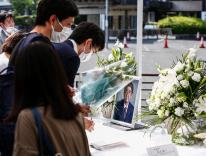MORE THAN ONE ECUMENISM?
I don’t understand how Russel Murray (“A New Ecumenism,” January 29) can assume that Anglicanorum coetibus signals a shift in the Catholic Church’s methodology for ecumenical engagement, especially in regard to Anglican and other churches of the Reformation (designated “ecclesial communities” in Pope John Paul II’s Ut unum sint because of the “invalidity” of their “episcopacy and Eucharist”). In Catholic ecclesiology, such Western churches of the Reformation are not “sister churches.”
In the 1990 CDF document Note on the Expression “Sister Churches,” Pope Benedict (then Cardinal Joseph Ratzinger) makes a point of stating that the “Second Vatican Council adopted the expression ‘sister Churches’ to describe the relationship between particular churches” of the East and the Catholic Church. He continues, “It must also be borne in mind that the expression ‘sister Churches’ in the proper sense, as attested by the common Tradition of East and West, may only be used for those ecclesial communities that have preserved a valid Episcopate and Eucharist.” (There is no mention of the churches of the Reformation at all.)
In this context, an Anglican community, not a sister church but a Western ecclesial community, cannot be put in the same category as an Orthodox one. Nor can “uniatism” be applied to Anglicanism. The Balamand Statement, which Russel Murray referred to in his essay, demonstrates why the Catholic Church needed to establish “personal ordinariates” for Anglicans—at least partly to distinguish the latter from Orthodox Christians. Finally, it would make sense, following Gianfranco Ghirlanda’s line of reasoning and Catholic ecclesiology, to define Anglicanism as “a patrimony of the Latin Church,” since Anglicanism came from the Western Latin Church of the sixteenth century, not from an Eastern church.
james chichetto, csc
North Easton, Mass.
THE AUTHOR REPLIES:
I would like to thank Fr. Chichetto for his comments and the editors of Commonweal for this opportunity to respond.
Chichetto’s objection to my argument—that Anglicanorum coetibus signifies a methodological shift in the Catholic Church’s ecumenical engagement with Anglicans—appears to rest on the following presumption: Because the Catholic Church distinguishes ecclesiologically between “churches,” such as the Orthodox churches, and “ecclesial communities,” such as the Anglican Communion, it engages churches and ecclesial communities with correspondingly different ecumenical methodologies. As more than four decades of Roman Catholic involvement in the ecumenical movement demonstrate, however, this presumption is false.
Since the close of the Second Vatican Council, the Roman Catholic Church has employed only one methodology, regardless of the church or ecclesial community with which it is engaged ecumenically. As I noted in my article, this is the methodology of mutual dialogue and common prayer, a methodology that seeks unity with Christians of other ecclesial traditions rather than absorption of them. It was for this reason that the Catholic Church disavowed uniatism: not because it somehow confused Orthodoxy with, for example, Anglicanism, but because it contradicted the ecumenism of the council. To resurrect it for Anglicans now seeking full communion with the Roman Catholic Church, which Anglicanorum coetibus effectively does, clarifies nothing. It only confounds.
During the canonization of forty martyrs from the age of the English Reformation, Paul VI said, “There will be no seeking to lessen the legitimate prestige and the worthy patrimony of piety and usage proper to the Anglican Church when the Roman Catholic Church...is able to embrace her ever beloved sister in the one authentic communion of the family of Christ: a communion of origin and of faith, a communion of priesthood and rule, a communion of the saints in the freedom and love of the Spirit of Jesus.” This is the ecumenism of the council. For all its good intentions, Anglicanorum coetibus is not a means to advance, never mind achieve, it.
russel murray, ofm
AN EXCELLENT INTRODUCTION
I was delighted to see David Gibson’s biographical essay on theologian David Tracy (“God-obsessed,” January 29). Relatively few people are acquainted with Tracy, even though he has played a major role in recent decades of religious thought. With the passing of theological “giants” like Congar, Rahner, and Barth, many have wondered if there would be Christian thinkers of equal stature to replace them. David Tracy is one reason for giving an affirmative answer.
His books and essays reflect what has happened to much serious religious thought in our day. Although his work deals with traditional issues, it does so within the broader context of today’s cultural developments. Tracy’s writings are on the cutting edge of the theology of culture. He is not, however, an “easy read.” Gibson’s essay provides an excellent introduction to Tracy’s complex thinking. My hope is that it will lead people to accept the challenge to become better acquainted with one of the leading thinkers of our day.
BERNARD COOKE
San Antonio, Tex.
TOO MUCH STUFF
In his column “Wasted Energy” (February 12), Charles R. Morris suggests that putting “the focus on carbon dioxide rather than oil distorts critical national interests.” But to focus on carbon dioxide or on oil is to miss the point.
The world’s industrial might is not producing carbon dioxide to create a warmer climate. The emission of carbon dioxide is a by-product of the production of “stuff” fueled by a boom in technology and our insatiable consumerism. If we focus on limiting the production of stuff, global warming just might take care of itself. This would mean looking hard at a stationary-state economy and a limit to wealth. Limiting wealth requires an equitable sharing of wealth, which in turn requires a simpler lifestyle. This would truly test our commitment to dealing with climate change.
JAMES T. DETTE
Weehawken, N.J.
Please email comments to [email protected] and join the conversation on our Facebook page.
Share
Previous Story
Religion Booknotes
Next Story
Joseph Cornell


